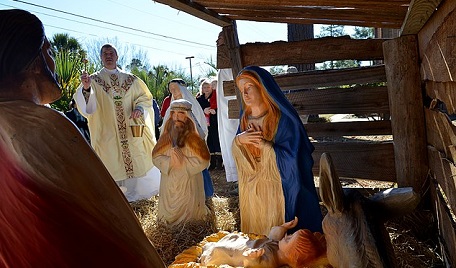 Each December, there are several disputes about the use of religious symbols in holiday displays in public locations. But did last year’s Supreme Court ruling about a high school football coach change the ground rules for nativity scenes and other displays?
Each December, there are several disputes about the use of religious symbols in holiday displays in public locations. But did last year’s Supreme Court ruling about a high school football coach change the ground rules for nativity scenes and other displays?
In Kennedy v. Bremerton School District, coach Joseph Kennedy sued after his contract was not renewed after Kennedy conducted voluntary prayers on a public football field after games. The Court’s decision in June 2022 all but abandoned a First Amendment test established by the late Justice Sandra Day O’Connor in the 1980s.
The First Amendment’s Establishment Clause states that “Congress shall make no law respecting an establishment of religion, or prohibiting the free exercise thereof.” In Lynch v. Donnelly (1984), the Court addressed a basic question: Did the First Amendment prohibit Pawtucket, Rhode Island, from including a nativity scene in its annual Christmas display—if it also included other secular symbols such as a plastic reindeer, a Santa Claus house, and a Christmas tree?
Chief Justice Warren Burger’s majority opinion allowed the crèche to stay in the exhibit, as the presence of secular symbols broadened the purpose of the display. But it was Justice O’Connor’s introduction of a First Amendment “endorsement test” in Lynch that had the longer constitutional legacy.
Justice O’Connor’s Endorsement Test
Earlier in Lemon v. Kurtzman (1971), the Court had established a three-part test to analyze Establishment Clause challenges. In what became known as the “Lemon test,” the Court found that the government can only assist religion if the primary purpose of such assistance was secular; the assistance did not promote nor inhibit religion; and there was no excessive entanglement between church and state.
O’Connor’s endorsement test, as she first offered in Lynch and later clarified in another case about a nativity display, County of Allegheny v. American Civil Liberties Union (1989), was an attempt to add clarity to the Lemon test. The endorsement test also had three parts: the first part asked if a government action endorsed region; the second part asked if the government’s actions made someone feel that they were outsiders; and the third part like Lemon forbade the entanglement of state and religious activities.
“In Lynch, I concluded that the city’s display of a crèche in its larger holiday exhibit in a private park in the commercial district had neither the purpose nor the effect of conveying a message of government endorsement of Christianity or disapproval of other religions,” O’Connor wrote in County of Allegheny in 1989. “The purpose of including the crèche in the larger display was to celebrate the public holiday through its traditional symbols, not to promote the religious content of the crèche.”
In the County of Allegheny case, the county had set up a crèche with a banner that read, “Glory to God for the birth of Jesus Christ.” The Court objected to that display. A second display outside the Allegheny County courthouse featured a menorah, a Christmas tree, and a sign honoring liberty. “We agree that the crèche display has that unconstitutional effect but reverse the Court of Appeals’ judgment regarding the menorah display,” said Justice Harry Blackmun.
Changing Tests and Religious Displays
Since then, O’Connor’s endorsement test and the Lemon test came into play in situations where religious and state actions potentially conflicted. But several newer court decisions had greatly diminished the Lemon and endorsement tests.
In Town of Greece v. Galloway in 2014, Justice Anthony Kennedy stated that the “Establishment Clause must be interpreted ‘by reference to historical practices and understandings,’” referring to his own concurring opinion in the County of Allegheny decision.
A 2019 Supreme Court decision, American Legion v. American Humanist Association, addressed the same question about the presence of a large cross on public property that was once privately owned. The Court’s majority did not use the Lemon test and again looked at “historical practices and understandings” to settle the First Amendment question.
In Woodring v. Jackson County, Indiana, in 2021, the Seventh Circuit Court of Appeals ruled that a nativity scene on public property that also included secular objects was permitted because it fit “with a long national tradition of using the nativity scene in broader holiday displays to depict the historical origins’ of Christmas—a ‘traditional event’ long recognized as a National Holiday.”
Last June, the Court’s majority left little doubt where it stood on previous religion tests. “This Court long ago abandoned Lemon and its endorsement test offshoot,” wrote Justice Neil Gorsuch in the 7-2 majority opinion in Kennedy v. Bremerton School District. “In place of Lemon and the endorsement test, this Court has instructed that the Establishment Clause must be interpreted by ‘reference to historical practices and understandings.’” Justice O’Connor’s test from the 1980s was formally abandoned.
Since Kennedy v. Bremerton, any legal challenge to religious symbolism on public property will need to be interpreted in a new light. In the wake of last year’s Supreme Court decision, there has been a general lack of nativity scene lawsuits during 2023.
However, there are several active lawsuits involving religious symbols on public property. In Arkansas, a dispute over a Ten Commandments monument dates back to 2017 and it is in federal court. In such cases, the Court’s new historical test will come into play.
Scott Bomboy is the editor in chief of the National Constitution Center.







